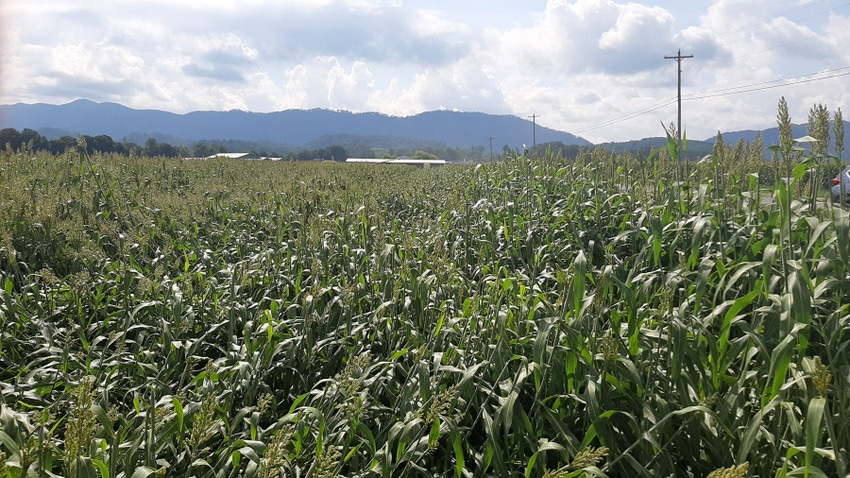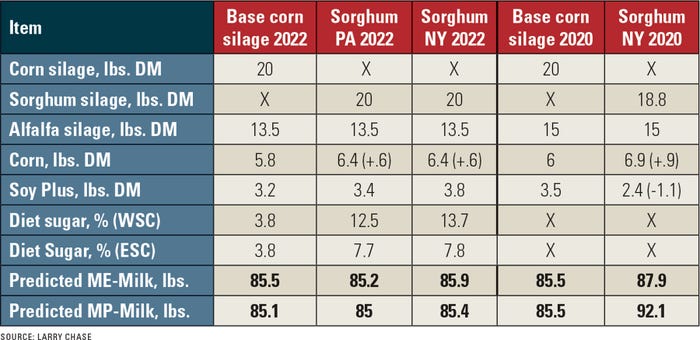April 26, 2023

A previous article I wrote covered the research behind enhanced nutrition in BMR forage sorghum. We tested the idea of using a male sterile BMR sorghum with a later harvest to replace corn silage.
Now, the rest of the story.
With data from the eight-week harvest, Larry Chase, emeritus professor of animal science at Cornell University, entered it into the Cornell Net Carbohydrate and Protein System model. This provided a prediction of how it would work in a real ration.
The ration was balanced for an 85-pound-per-day production level. For the 2022 growing season, we went eight weeks after sorghum heading, the same as corn silage after tasseling, instead of six weeks. The longer, enhanced nutrition of the eight weeks required only 0.6 of a pound of corn meal to equal a good corn silage in the diet. This was the same for the Pennsylvania trial and the northern New York trial.
The 2020 study, which went only six weeks after heading, required 0.9 pound of corn meal.

A critical point in the economics is that the 2020 study had sufficient manure nitrogen to supply the latter part of the season. The resulting forage crude protein (11%) enabled the ration to be reduced 1.1 pounds of protein per cow per day, a savings of $5,000 a year for 100 cows. This more than offset the slight increase in cornmeal cost.
Neither of the 2020 sites had sufficient nitrogen to support an 11% protein level. Previous research has found that 11% crude protein is the norm for BMR forage sorghum if fertilized properly.
A closer look at protein
This year, we are planting a New York Farm Viability Institute research project to determine the optimum nitrogen, plus sulfur, to raise the protein level in forage sorghum. Our hypothesis is that the nitrogen for yield will level out before the nitrogen necessary for supporting crude protein.
We have seen similar results in winter triticale nitrogen studies. We also hypothesize that manure may be a superior source of N because of the gradual release of organic matter throughout the summer.
Any manure application needs to be incorporated within an hour of spreading to capture the ammonia nitrogen. This is why more farms are adding manure injection as a standard economic and environmental practice in their operation.
Location, location, location
In selecting BMR male sterile forage sorghum varieties, you must work backward in the season.
When will you harvest? You need to start timing at eight weeks before, as this is when the variety you select should have headed out. The number of days before that is when it should be in the ground, and that latter number is determined by genetics.
Have your dealer show you when it will head out. It is important to get this right. In more northern areas, you will be potentially squeezed between heading time and soil temperature needed for planting. Sorghum is not corn silage. It is critical the soil temperature be above 60 degrees F (preferably above 65), with the forecast for warmer temperatures the week after planting.
Don’t make the mistake I made of planting into soil that was 72 degrees but three days later was cold — 40 degrees — and rainy. This killed the entire research project.
If you are planting farther south, say southern Pennsylvania or Maryland, you must pay attention to the effects of warmer weather on the crop.
In our trial, we had a single male sterile sorghum head for the first five weeks with enhanced nutrition building. The weather got hot and sunny, so the plant sent out lateral shoots from each node. There were up to nine male sterile heads emerged.
The result was that total digestible nutrients and nonfiber carbohydrate components plummeted, and the undigestible uNDF240-NDF and lignin fractions increased tremendously.
If you are farming in an area with a longer and hotter growing season, you may have to select a full-season variety that heads out the second half of August or wait to plant a shorter variety that heads out the second half of August. This should keep the plant from activating lateral shoots.
Keep rows narrow
Drilling in narrow rows, or 15-inch rows, is far superior to planting in 30-inch corn rows.
My research has found that sorghum yielded 18% more when drilled than when planted in a traditional corn row width. The more uniform spacing increases stalk size and decreases lodging potential.
Even without a heavy fertile seed head on male sterile sorghum, too high a population for the row space will increase lodging. If you insist on 30-inch row spacing using a traditional planter, then we suggest a maximum 4 pounds of seed per acre. For 15-inch rows, we recommend 5 to 6 pounds per acre. For drilling, we recommend 6 to 7 pounds of seed per acre.
Don’t let anyone convince you to plant higher population or it will be lodged at harvest. We do not do that with corn, so do not do it with forage sorghum.
Check older drills when you plant these low populations, as you may be planting sorghum flour instead of seeds. If at the low seeding rate the mechanism is smaller than the seed size, it will grind the seed, and nothing will grow. If this happens, set the drill at double the desired population and then plug every other hole to increase the row spacing. This is not ideal, but it is better than planting sorghum flour.
Apply herbicide quickly
Unless you are organic, have the seed treated with a safener. This allows you to use atrazine and metolachlor (dual-type) herbicides to control weeds.
Sorghum in warm, wet conditions can emerge in three to four days, so you need to apply herbicide as soon as you are finished planting. Any delay will allow weeds to get started.
Stay clear of fertile plants
Do not plant near or downwind of fertile sorghum, sorghum sudangrass, sudangrass or johnsongrass stands that are allowed to head. They will fertilize the male sterile sorghum and completely ruin the nutrient enhancement.
The heads of male sterile sorghum are receptive to pollen for about two weeks.
Hopefully, we will get a planting in the Catskill Mountains of New York this year. At 26% sugar on a dry matter basis, we want to find out if bears in this candy store will be a problem!
Kilcer is a certified crop adviser in Rutledge, Tenn., formerly of Kinderhook, N.Y.
About the Author(s)
You May Also Like




